Roughly 1 in 10 British gardens has a pond – about two million in total – and these form an incredibly important network of wetland habitats throughout our urban areas. In addition to the wildlife that lives in and around ponds, they are also the focus of interest for passing mammals and birds.
Learn how to build and care for your wildlife pond with our expert guide, including best pond plants to grow each season and how to attract more visitors to your pond.
Foxes, badgers, wood pigeons, blackbirds and starlings drink or bathe in them (a branch across your pond will encourage birds), and hedgehogs hunt slugs and invertebrates in the long vegetation around their edges, especially in hot, dry weather.
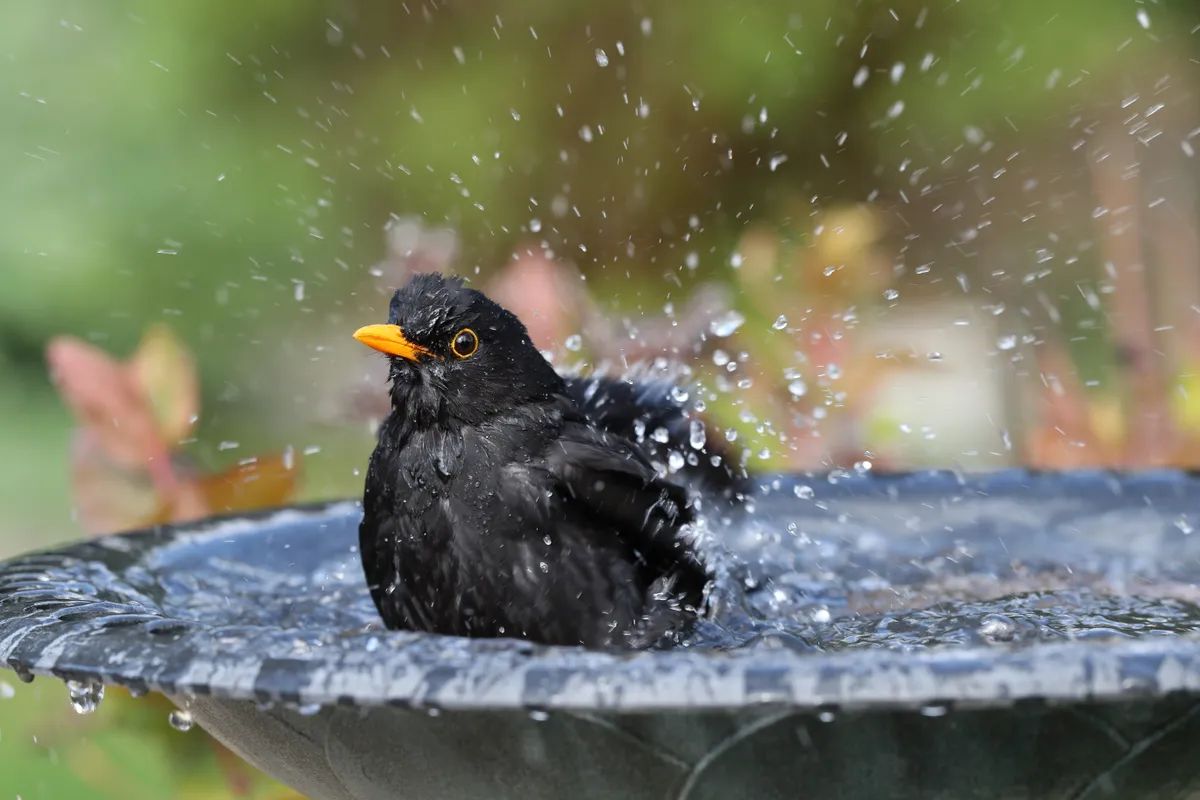
Where you dig your pond is critical: shadier sites will host different species to sunnier ones, while a shallow pond in a hot spot will be subject to excessive evaporation and algal blooms. In fact, small ponds are prone to drying out, so it’s best to position them in sheltered locations.
And while shallow ponds will be good for common species such as frogs and palmate newts, larger, deeper ones are more likely to be inhabited by toads and even great crested newts. If you have the space, more than one pond in various locations with different designs and plant species will add to the overall wildlife diversity in your garden.

Pond wildlife to spot each season
Wildlife to attract in summer
- Ponds attract flocks of birds, such as starlings, to bathe, foxes to drink, and sparrows and pipistrelle bats to feed on their abundant insects.
- Damselflies/dragonflies will lay their eggs on aquatic plants or drop them onto the surface of a pond throughout the summer.
- Common pondskaters are bugs that live on the surface of a pond, where they grab and eat the insects that fall into the water.
- Common backswimmers fly at night and are one of the first species to colonise a pond. They are voracious predators of other aquatic life.
- Daphnia waterfleas are eaten by adult and larval newts, as well as other aquatic insects. They filter algae from the water and thereby help to keep a pond clear.

Winter pond wildlife
- A few common (smooth) newts will overwinter in a pond, as will frogs and any tadpoles that did not emerge the previous summer.
- Great pond snails are less active in the winter and are generally found in the deeper parts of a pond. In the summer, they are often seen at the surface, gulping in air.
- Dragonfly nymphs spend three or four years in a pond before emerging as adults; they do not pupate. They feed on other invertebrates and larger nymphs hunt tadpoles.
- Water hog-lice (Asellus spp) are extremely abundant in the detritus at the bottom of ponds, and eat rotting vegetation. They resemble, and are close relatives of, wood lice.
What will I find if I go pond dipping in winter?
You can find plenty of wildlife says zoologist Jules Howard. Dragonfly nymphs, damselfly nymphs, a host of water beetles, water boatmen, backswimmers, water hog-lice, leeches, mayfly nymphs, caddis fly nymphs – all of these creatures overwinter in ponds, and are active and easily visible on even the coldest days.
In fact, for many aquatic invertebrates winter is an important time for growth in preparation for their crucial breeding endeavours in spring. There’s even an argument that pond food-webs become re-energised in winter, aided by the increased oxygen content (cold water retains more oxygen) and the influx of dead leaves in autumn on which detritivores flourish.
Some ponds may also contain overwintering tadpoles, a phenomenon that might be more common than we imagine. In particularly mild winters adult amphibians continue to be active too – I have seen newts hunting in the water in mid-December.
However, during colder wintry spells frogs may retreat to the depths where they sit motionless, breathing through their skins. So if you do go dipping, take care not to disturb them.
Why are some pond snails red?
Compared to other habitats, ponds are naturally very low-oxygen environments. As a result, pond-dwellers have developed various adaptations to ensure that each and every breath counts.
Ramshorn snails are particular pioneers. Unlike most of Britain’s 40 or so freshwater snail species, all of which surface regularly to gather oxygen, members of this incredible family have come across an entirely new way of breathing.
In contrast to most molluscs, which use copper atoms (hemocyanin) to transport oxygen through their cells, ramshorns, like humans, use iron atoms (haemoglobin) – and it’s this that gives their blood and bodies a red tinge. In all but the coldest environments, haemoglobin performs more efficiently than hemocyanin as a method of carrying oxygen around the body.
How the ramshorns hit upon this adaptation is not fully known. The snails’ haemoglobin molecules resemble those commonly stored in muscles tissues, suggesting that these molecules broke free from muscles and were later co-opted to assist in respiration.
This question originally appeared as Q&A in BBC Wildlife, and was answered by Jules Howard.
What are the best plants for your wildlife pond?
Ponds with the greatest variety of plants have the greatest range of wildlife, so grow a diversity of species and control the more vigorous ones.
Pond plants are expensive to buy, but most pond owners pull out masses each year, so get them for free from friends.
Oxygenators are submerged plants that oxygenate the water and they are an important food source and habitat for aquatic life. Grow curled pondweed, mare’s tail, water milfoil and water-starwort. Yellow water lilies have both submerged leaves that provide oxygen and surface leaves that offer shade.
Marginals grow around pond edges and flower above water, providing perches and food for hoverflies and bees. Plant bur reed, flowering rush, great spearwort, water plantain, water speedwell and yellow flag (iris sawfly larvae eat the leaves).
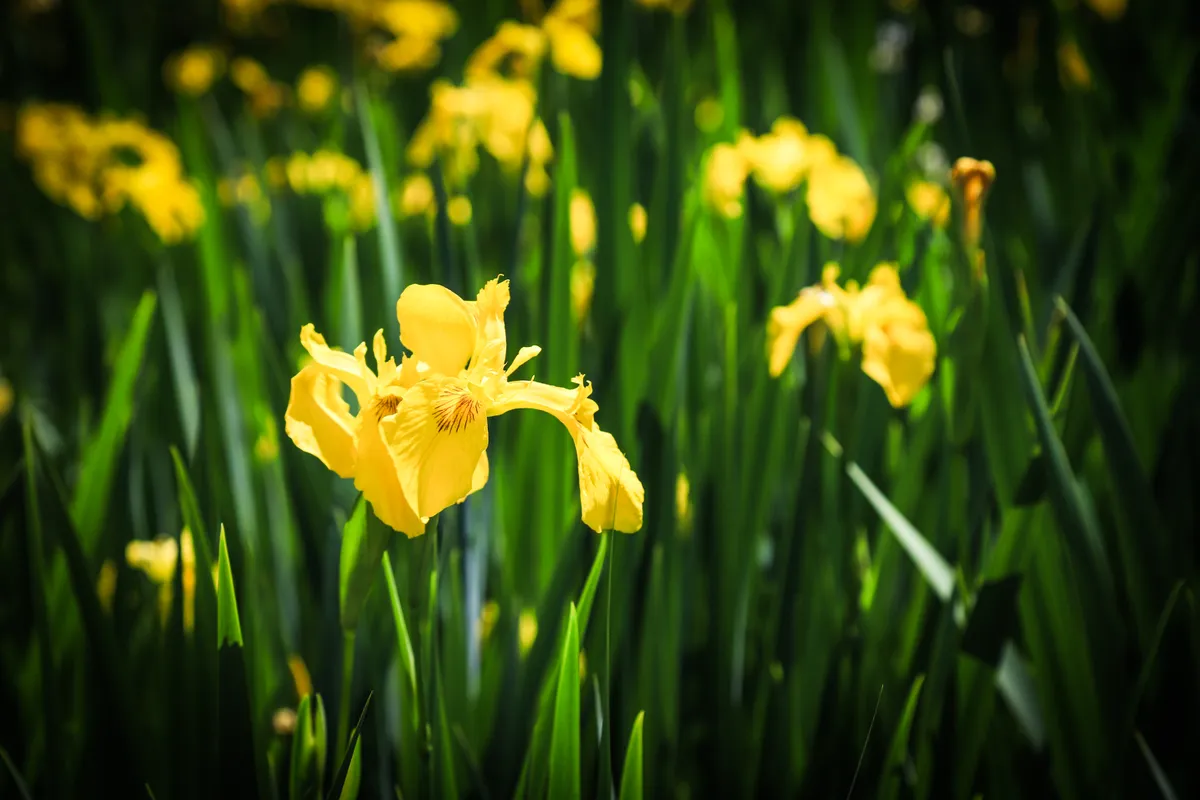
Bog plants grow in wet ground. Plant bog bean, St John’s wort, creeping Jenny, fleabane (to attract insects), greater bird’s foot-trefoil (bees), hemp agrimony (butterflies), lady’s smock (the foodplant of orange tip butterfly larvae), marsh marigold, meadowsweet, purple loosestrife (hoverflies), rushes, sedges, watercress, and water forget-me-not.
Avoid invasive alien plants, such as Australian swamp stonecrop, Nuttall’s pondweed and parrot’s feather (all sold in garden centres). And steer clear of floating plants such as water fern. They choke the surface, reducing light and oxygen levels, and therefore diversity.
How to create a thriving wildlife pond
1
Care for your wildlife pond throughout the year
It’s best to dig a pond in the autumn when the ground is soft, then let it fill up with rainwater and leave it to settle over winter. Clean it out in late autumn/early winter, but search through the removed vegetation to release trapped animals, or spread it around the pond’s edges so they can creep back into the water.
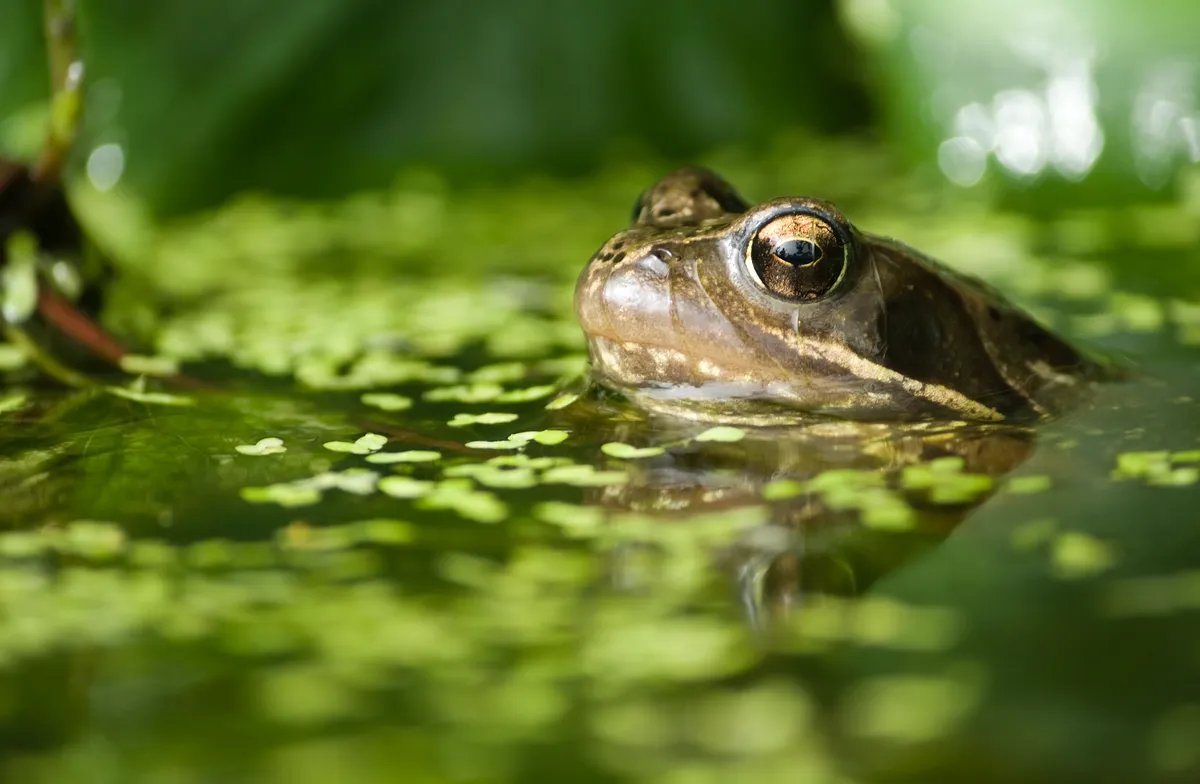
2
Design your own wildlife pond
Preformed ponds are easier to install than those with butyl rubber liners, but a liner will enable you to design a more varied pond, with shallow sloping sides and a variety of depths. A maximum depth of at least 75cm will ensure that your pond does not completely freeze over during a hard winter.
3
Remove plants that clog up the pond
Blanketweed and green algae tend to be a problem in new ponds and those with a large amount of water in direct sunlight. Remove blanketweed by hand and position plants at the pond margins to provide shade and so reduce water temperature.
4
Let the water rise and fall through the year
Let the water level drop in the summer; damp mud is a good habitat for invertebrates. Even if the pond needs topping up, never do it with tap water (if tap water is the only option available, leave the water to stand in a bucket or water can for 24 hours before adding to the pond).

5
Use mesh to child-proof your pond
If you have small children, either surround your pond with a fence or install a metal mesh or plastic grid just above the water surface that will support the weight of a child. Plants will grow through, and the mesh will also help to reduce the amount of debris that blows into the pond in the autumn.
6
Add invertebrates that won't colonise otherwise
Most insects and amphibians will colonise your pond naturally, but you will need to add water snails (both ramshorn and great pond snails), and species such as freshwater shrimp, waterlouse and freshwater (swan) mussels.
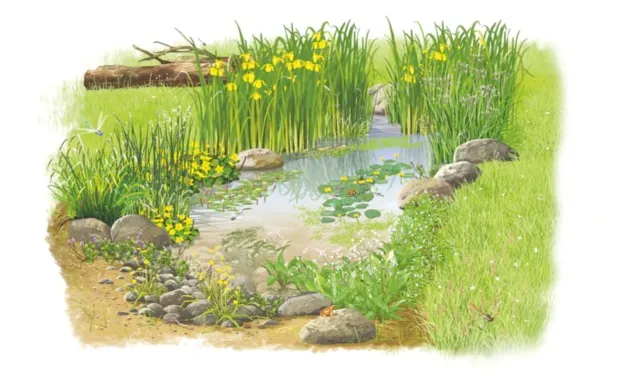
See our how to make a wildlife pond with our handy step-by-step guide
How to photograph pond minibeasts
Learn how to photograph the wildlife in your pond, with photographer Laurie Campbell.
It’s often said that one of the most beneficial things you can do to attract wildlife to your garden is to create a pond. It needn’t be particularly big – even some sort of water feature in a container will be seen as an oasis where everything from garden birds to foxes will almost immediately come to drink.
Later, as the pond becomes established, whole communities of aquatic life begin to form. Because you have regular access, you are in the perfect position to observe and document the changes as a steady variety of potential subjects find their way to your creation. In terms of minibeasts, these can be loosely divided into those that can be photographed on and above the surface, such as pond-skaters, whirligig beetles and damselflies, and those below, such as three-spined sticklebacks and caddis-fly larvae that require being photographed in a carefully prepared tank.
Getting acquainted with ponds and their diminutive inhabitants can open up a whole new world of photographic potential. Here are three ways to capture them on camera:
Southern hawker dragonfly
This was my first ever sighting of a southern hawker, and all the more exciting because it turned up in my garden pond. Normally I would choose a telephoto macro lens attached to a tripod and stalk the subject, but for this image I used a hand-held camera fitted with a fisheye lens.
Insects are less likely to flee from your approach when the air is cooler. I took this photo in mid-October, but in warmer months try early or late in the day.
With the dragonfly less than 15cm away, the 180-degree angle of view of the fisheye lens allowed me to show it within its surroundings. The inclusion of the summerhouse points to a garden setting.
It’s hard to use tripods with fisheye lenses because of the problem of including the legs in the picture, so I supported the camera for the 1/40-sec shutter speed by resting both my elbows on the ground.
Crouching low down allowed me to compose the dragonfly against the sky, avoid casting my shadow over the scene and keep my subject at ease by appearing largely below the skyline.
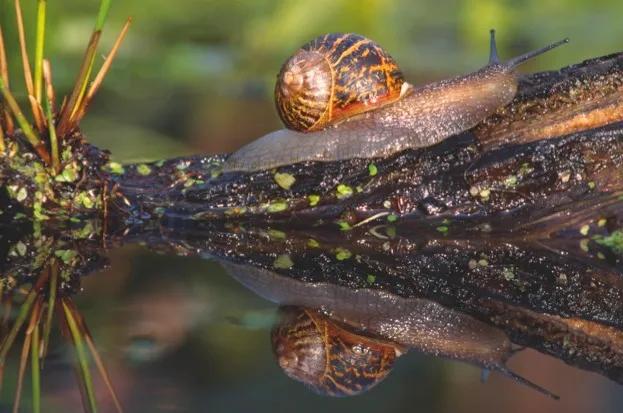
Garden snail
Taking photographs around water may give you the chance to work a reflection into the composition. For this image of a snail on a log, the low viewpoint and calm conditions with the sun low in the sky from behind created the perfect combination. Virtually any subject would look good in this situation.
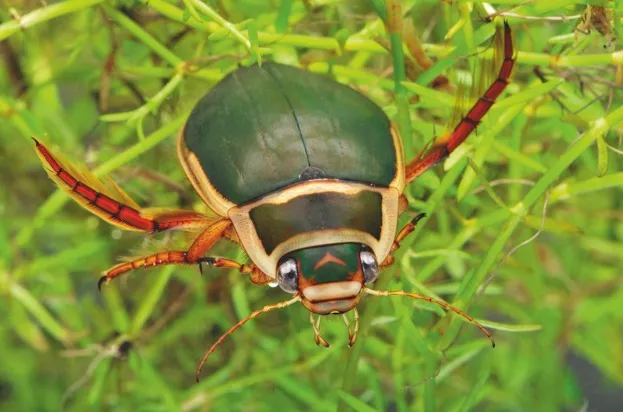
Great diving beetle
The only way to capture this beetle was to place it in a small glass tank with some pondweed and photograph it through the side, indoors and in subdued lighting to avoid reflections from the glass. The scene was lit by a single electronic flash that was fitted with a diffuser and positioned to fire directly down into the water from above.